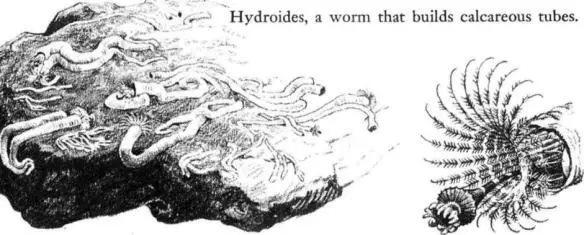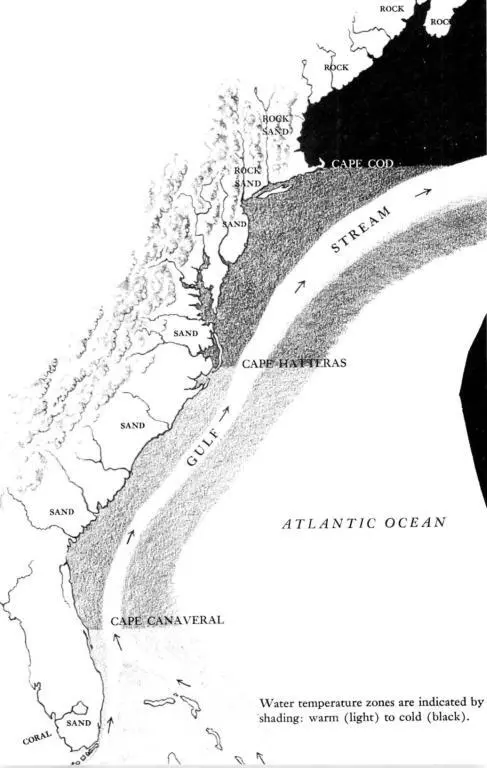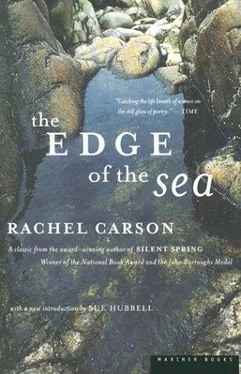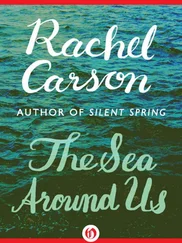For the long-stalked kelps that sway in dusky forests just below the level of the spring tides, survival in the surf zone is largely a matter of chemistry. Their tissues contain large amounts of alginic acid and its salts, which create a tensile strength and elasticity able to withstand the pulling and pounding of the waves.
Still others—animal and plant—have been able to invade the surf zone by reducing life to a thin creeping mat of cells. In such form many sponges, ascidians, bryozoans, and algae can endure the force of waves. Once removed from the shaping and conditioning effect of surf, however, the same species may take on entirely different forms. The pale green crumb-of-bread sponge lies flat and almost paper-thin on rocks facing toward the sea; back in one of the deep rock pools its tissues build up into thickened masses, sprinkled with the cone-and-crater structure that is one of the marks of the species. Or the golden-star tunicate may expose a simple sheet of jelly to the waves, though in quiet water it hangs down in pendulous lobes flecked with the starry forms of the creatures that comprise it.
As on the sands almost everything has learned to endure the surf by burrowing down to escape it, so on the rocks some have found safety by boring. Where ancient marl is exposed on the Carolina coast, it is riddled by date mussels. Masses of peat contain the delicately sculptured shells of mollusks called angel wings, seemingly fragile as china, but nevertheless able to bore into clay or rock; concrete piers are drilled by small boring clams; wooden timbers by other clams and isopods. All of these creatures have exchanged their freedom for a sanctuary from the waves, being imprisoned forever within the chambers they have carved.
The vast current systems, which flow through the oceans like rivers, lie for the most part offshore and one might suppose their influence in intertidal matters to be slight. Yet the currents have far-reaching effects, for they transport immense volumes of water over long distances—water that holds its original temperature through thousands of miles of its journey. In this way tropical warmth is carried northward and arctic cold brought far down toward the equator. The currents, probably more than any other single element, are the creators of the marine climate.
The importance of climate lies in the fact that life, even as broadly defined to include all living things of every sort, exists within a relatively narrow range of temperature, roughly between 32° F. and 210° F. The planet Earth is particularly favorable for life because it has a fairly stable temperature. Especially in the sea, temperature changes are moderate and gradual and many animals are so delicately adjusted to the accustomed water climate that an abrupt or drastic change is fatal. Animals living on the shore and exposed to air temperatures at low tide are necessarily a little more hardy, but even these have their preferred range of heat and cold beyond which they seldom stray.
Most tropical animals are more sensitive to change—especially toward higher temperatures—than northern ones, and this is probably because the water in which they live normally varies by only a few degrees throughout the year. Some tropical sea urchins, keyhole limpets, and brittle stars die when the shallow waters heat to about 99° F. The arctic jellyfish Cyanea, on the other hand, is so hardy that it continues to pulsate when half its bell is imprisoned in ice, and may revive even after being solidly frozen for hours. The horseshoe crab is an example of an animal that is very tolerant of temperature change. It has a wide range as a species, and its northern forms can survive being frozen into ice in New England, while its southern representatives thrive in tropical waters of” Florida and southward to Yucatán.
Shore animals for the most part endure the seasonal changes of temperate coasts, but some find it necessary to escape the extreme cold of winter. Ghost crabs and beach fleas are believed to dig very deep holes in the sand and go into hibernation. Mole crabs that feed in the surf much of the year retire to the bottom offshore in winter. Many of the hydroids, so like flowering plants in appearance, shrink down to the very core of their animal beings in winter, withdrawing all living tissues into the basal stalk. Other shore animals, like annuals in the plant kingdom, die at the end of summer. All of the white jellyfish, so common in coastal waters during the summer, are dead when the last autumn gale has blown itself out, but the next generation exists as little plant-like beings attached to the rocks below the tide.
For the great majority of shore inhabitants that continue to live in the accustomed places throughout the year, the most dangerous aspect of winter is not cold but ice. In years when much shore ice is formed, the rocks may be scraped clean of barnacles, mussels, and seaweeds simply by the mechanical action of ice grinding in the surf. After this happens, several growing seasons separated by moderate winters may be needed to restore the full community of living creatures.


Because most sea animals have definite preferences as to aquatic climate, it is possible to divide the coastal waters of eastern North America into zones of life. While variation in the temperature of the water within these zones is in part a matter of the advance from southern to northern latitudes, it is also strongly influenced by the pattern of the ocean currents—the sweep of warm tropical water carried northward in the Gulf Stream, and the chill Labrador Current creeping down from the north on the landward border of the Stream, with complex intermixing of warm and cold water between the boundaries of the currents.
From the point where it pours through the Florida straits up as far as Cape Hatteras, the Stream follows the outer edge of the continental shelf, which varies greatly in width. At Jupiter Inlet on the east coast of Florida this shelf is so narrow that one can stand on shore and look out across emerald-green shallows to the place where the water suddenly takes on the intense blue of the Stream. At about this point there seems to exist a temperature barrier, separating the tropical fauna of southern Florida and the Keys from the warm-temperate fauna of the area lying between Cape Canaveral and Cape Hatteras. Again at Hatteras the shelf becomes narrow, the Stream swings closer inshore, and the northward-moving water filters through a confused pattern of shoals and submerged sandy hills and valleys. Here again is a boundary between life zones, though it is a shifting and far from absolute one. During the winter, temperatures at Hatteras probably forbid the northward passage of migratory warm-water forms, but in summer the temperature barriers break down, the invisible gates open, and these same species may range far toward Cape Cod.
From Hatteras north the shelf broadens, the Stream moves far offshore, and there is a strong infiltration and mixing of colder water from the north, so that the progressive chilling is speeded. The difference in temperature between Hatteras and Cape Cod is as great as one would find on the opposite side of the Atlantic between the Canary Islands and southern Norway—a distance five times as long. For migratory sea fauna this is an intermediate zone, which cold-water forms enter in winter, and warm-water species in summer. Even the resident fauna has a mixed, indeterminate character, for this area seems to receive some of the more temperature-tolerant forms from both north and south, but to have few species that belong to it exclusively.
Читать дальше














